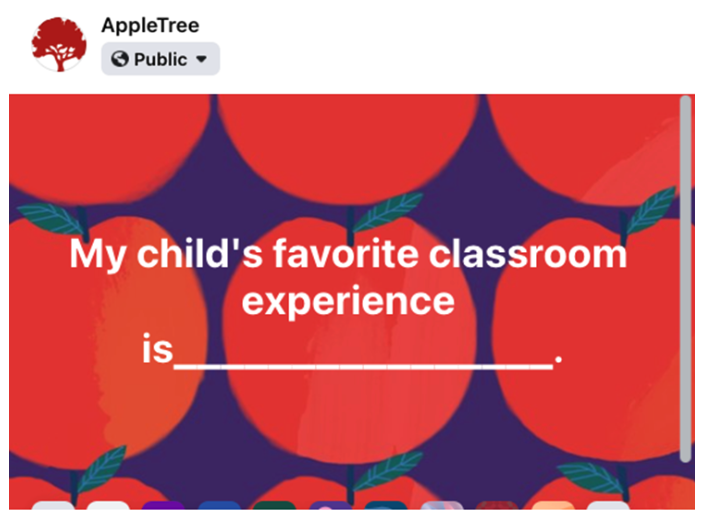It’s time to revamp your Facebook strategy. Yes, your student prospects are on Instagram with your younger parents, but Facebook is still important. And things have changed at Facebook.
Our blog series for school marketers continues with a deep dive into creating better, more strategic Facebook content in light of the new changes at the social media giant. We even tackle the new Facebook Reels feature to give you the skinny on this newest feature.
Facebook has, once again, switched up its algorithm to favor more live and recorded video in viewers’ newsfeeds. They specifically want to make Facebook and Instagram (which Facebook owns) feeds more like TikTok. It’s still about creating “meaningful engagement” – publishing content that spearheads conversations and get viewers to talk to one another – but it’s focused on video.
Facebook also is using AI (artificial intelligence) to curate content. This means showing content the algorithm thinks the viewer will be interested in, and giving users a greater ability to choose the type of content they want to see in their feeds.
What’s best practice right now?
The key to meaningful engagement is sharing a variety of Facebook content and designing your posts (whether text-based or video) to engage the community.
Publishing video is most important. Research indicates that video overall has more exposure and has a longer shelf life than any other type of content. Use video to showcase your school and get viewers to react, share and truly engage.
Video is the hottest content in town because:
- It gets more exposure and engagement.
- It’s growing in popularity throughout all social channels.
- It appeals to your Gen Z audience.
- It has a longer shelf life than text.
- In can be repurposed amongst multiple platforms.
- It humanizes your school through a deeper, more personable and emotional connection.
Telling your story in pictures, not words, is essential to your strategy. Research indicates that many viewers, especially on mobile devices, view images and videos rather than read the text posted above.
Meta (Facebook/Instagram) Facebook has placed more emphasis on publishing video content than ever before, including published posts. While Stories and Facebook Live have been around for a while, and Reels, which came out in 2021 and went global in February 2022, is now Meta’s.
Facebook Reels may not necessarily be a top item for schools or the most beneficial to your marketing strategy, but it’s worth knowing some basics and using it as one of several video options.
- Unlike Stories, Reels won’t disappear after 24 hours.
- Reels are working best for Pages that are already popular and have lots of engagement.
- Facebook Reels can only be 60 seconds vs. Instagram Reels that can be 90 seconds. Reels perform much better on Instagram because that platform is designed to be a creative platform.
- Best-practice design tips: Shoot in high-resolution, use a sound clip, shoot vertically, use fun filters and be entertaining. This is NOT the place for your head of school to announce Back-to-School Nights. Think spirit rallies and student-life clips that show lots of life and fun.
Check out Facebook’s guide to creating Reels and read Hootsuite’s recap to decide if Reels will work for your school.
Other Important Facebook Strategies
Continuing to use Facebook Groups is a great way to have meaningful conversations with your audience. Groups can focus on a topic of interest to everyone in the group (your school’s sports teams, alumni, etc.) and have a dedicated facilitator who helps to keep the conversation flowing. When they interact with your content, their interactions, along with your school’s responses, will be shared in their own news feeds with their own friends who could be potential prospects for your school.
You have several options for content and should be including these options to create content that is varied, interesting and user-focused. Make sure your weekly social media calendar has a variety of each.
For non-video posts, allow your creativity to tell the story. While you will need some words, less is more. Include no more than two to three sentences with compelling calls-to-action or CTAs, which are (what you want your readers to do).
Examples include:
- What do you like most about [your school]?
- Discover how your preschooler can code!
Use Facebook Creator Studio to craft and publish posts. It has all the tools you need to effectively post, manage, monetize and track the performance of content across ALL your Facebook Pages and Instagram accounts in one place. And you can schedule your content at the most optimal times for publishing.
Text-only Posts have begun to get higher engagement than posts with images. Incorporate text-only posts, which are questions or statements, into your Facebook content mix. Test publishing this type of text with and without a colorful Facebook background to learn which type gets the best results and gets people talking.

Use a fill-in-the-blank (e.g., “My child’s favorite classroom experience is_______.” In the first comment, offer people a place on your website to “learn more” about your school.
Try statements like “Post-pandemic, many parents are very concerned about their child’s mental health and social skills. What are you most concerned about?” Leave a comment with a link that directs readers to your school’s information on how you are helping students deal with social emotional learning and mental health issues, for example.
When you have “Breaking News,” post it as a text-only post with a link to the rest of the information as a comment.
Posting cadence: Intertwine text-only posts at least two out of three days each week to influence “meaningful engagement” to help further reach and be seen in your followers’ and their friends’ newsfeeds.
Responding to Comments
Facebook’s algorithm pays greater attention to Pages that encourage “meaningful engagement,” getting your community to openly interact with and comment on your posts. To further drive engagement, it is essential to respond to as many comments and questions as you can to show that your school is interested in what your followers have to say. By doing so, people will continue to engage with the content you post on the Page and boost your visibility to a new audience of prospective families on Facebook.
It’s important that your Facebook Page clearly states your school’s Facebook Guidelines so your user community knows what your stance is – and you can refer to it, should you need to hide, report or remove a comment.
Suggested language:
[SCHOOL NAME] welcomes all questions and commentary, including constructive feedback. We don’t take decisions on moderating posts lightly. But we do expect that participants post content and commentary that is both relevant and respectful to this community. We have the following community guidelines:
We will remove bad language, spam, off-topic or defamatory comments
Don’t post anything that isn’t yours to post
We’ll take down any posts we find to be in violation of any of the above or Facebook Community Standards | Transparency Center
Should you delete a negative or trolling comment?
There is no right or wrong answer here, but a good, constructive first step is to step away from your computer for a few minutes and get another opinion.
You may even want to take the conversation off the Page and respond to the person individually rather than blowing up the situation by responding to them on the Page, which could cause even more problems.
If you remove your emotions, is the comment rooted in constructive criticism? Is it a misunderstanding? Addressing the root of the comment, fairly and authentically (and with the OK of your communications office first) is important. Own up to any mistakes your school may have made that prompted the comment. Tell your side of the story, if that is warranted. Your audience will appreciate an honest discussion.
But, if the comment is offensive and out of line, delete it and move on.
Using a Content Calendar
A weekly content calendar is a strategic tool that will help you plan out your social media content in advance. Most important, it keeps you from having to figure out what to publish at the last minute, will keep you on track, and help you avoid typos and risk the consequences of a big mistake.
There are a wide variety of methods to create an editorial calendar. You can find editorial calendar templates on Hootsuite or Hubspot or create one yourself on Google.
Include all your posts for every platform. This way you can see your entire plan in one place and know which of your social sites would benefit from more attention. Keep in mind that you will probably have to make last-minute changes for late-breaking news or announcements.
List each day of the school week and choose a focus for each day. If one of your goals is to drive lower school enrollment, make sure one day is focused solely on news about your lower school. Maybe you have “Thought-Leader Thursday” and focus on one of your school leaders with content parents will be interested in. Think about what makes your school distinctive and make sure there is appropriate content for it.
Intertwine text-only posts at least two out of three days each week to influence “meaningful engagement” to help further reach and be seen in your followers’ and their friends’ newsfeeds.
Layer in “real-time” relevant stories, which may include:
- Educational tips, how to’s and resources for parents
- Q&As format to get your audience talking and asking questions themselves
- Behind-the-scenes videos such as “Day in the life” with a variety of subjects/voices
- Teasers or sneak peaks for upcoming events
- Internal and external breaking news that impacts your students and families, key birthdays/special anniversaries, holidays, etc.
- Something special that took place at the school
- Event updates following an event
- Invites to your Facebook Groups – Think “Parent Ambassadors’ Group”
- And even a Facebook Live event that’s presented by faculty or students every week or two.
And don’t forget about “oldies but goodies.” #TBT (Throwback Thursday) is still a thing, and your audiences LOVE looking at archival photos from your school’s days of yore. Post a photo, ask them to identify what is going on in the photo, who is in the photo, etc. These can connect with your school’s current day traditions. Getting ready for the big rivalry basketball game? Post a few older photos from games past and ask for comments about their favorite memories of cheering for your school. Or try creating the #TBT as a Facebook Reel.
When is the best time to post?
It’s important to get engagement within the first few hours of posting so that the algorithms will show your posts to more of your audience. Finding the right times to post for your brand can help with that. To learn the best times to post, under Manage Page, click on your Facebook Insights, scroll down to Meta Business Suite and click on Posts and Stories. Though the information isn’t an exact science for scheduling, it is a good road map for knowing when your audience is online.
Take note of the posts that received the most engagement, reactions/likes and comments along with the time of day. Schedule upcoming posts at the same time.
Check back on these insights from week to week to help determine optimal times to publish your content. You could schedule a few weeks’ of social media posts all at once or do it on a weekly basis. Three to four weeks of posting should give you enough data to work with to find your best times for morning, afternoon and night.
The best days and times to post on Facebook come during the weekday as shown by this graph. IMPORTANT: This chart is not just for the education community. In our experience, postings for schools are best on weekdays from 7-10 am, 12- 2 pm and 7-9 pm.
While researching the best time to post on Facebook can seem like a trivial step, the competition for newsfeed real estate is immense and the reach is extremely low. The only way you can beat it is if you are very meticulous with your posting strategy. Pay special attention to the time that you post.
Check out our first post in this series on Integrating Your Social Media.
Need help crafting the best Facebook strategy? Give us a call. We’ve got the know-how to help.


